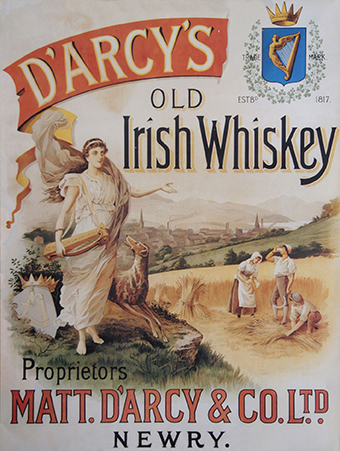A piece of commercial art with a political message?
Published in Issue 6 (November/December 2020), News, Volume 28By Tony Canavan
 I first came across this poster advertising Matt. D’Arcy’s Irish whiskey in an art gallery in Dublin about fifteen years ago. It is a distinctive image of a barefooted Hibernia, a harp slung over her shoulder and an Irish wolfhound at her feet. She is pointing over agricultural fields to the town of Newry dominating the valley of the Clanrye River. The town is bristling with chimney-stacks and factories, its harbour a forest of ships’ masts. The fields below Hibernia are full of golden barley being harvested by happy peasants.
I first came across this poster advertising Matt. D’Arcy’s Irish whiskey in an art gallery in Dublin about fifteen years ago. It is a distinctive image of a barefooted Hibernia, a harp slung over her shoulder and an Irish wolfhound at her feet. She is pointing over agricultural fields to the town of Newry dominating the valley of the Clanrye River. The town is bristling with chimney-stacks and factories, its harbour a forest of ships’ masts. The fields below Hibernia are full of golden barley being harvested by happy peasants.
All this is symbolic of a happy, prosperous land, which Ireland was not when the poster was distributed in the 1880s. This was a period of much poverty, the Land War and agitation for Home Rule under the leadership of Charles Stewart Parnell. When I noticed that Hibernia was standing beside a shield bearing the arms of Ireland beneath a crown (which also features prominently at the top of the poster), it struck me that there might be a political message in this painting. The wolfhound is a common symbol of Ireland, but the other symbols were more specific. The golden harp on a blue shield was the heraldic arms of Ireland as a kingdom (used today for the office of the president), while the crown over the shield is a five-pointed one, often referred to in heraldry as the ancient crown of Ireland from the belief that this was the kind of crown worn by Irish kings and high-kings. Taken together, they become a symbolic representation of an independent Ireland. There is a distinct absence of anything in the poster to indicate that Ireland was under British rule or part of the United Kingdom. What the poster seems to be saying is that Ireland will be a happy and prosperous country once it gets its own parliament.
All this was speculation on my part. I know the history of Newry well and that it had always had a strong patriotic element. The United Irishmen and the Young Irelanders were both represented in the town—for example, John Mitchel, the Young Irelander, was a Newryman. I knew, too, that there was strong support for Home Rule, and subsequently independence, so it was not unreasonable to suppose that the poster was indeed a subtle piece of political propaganda. I only recently, however, received confirmation of this. Local man Michael McKeown is in the process of reviving the Matt. D’Arcy distillery. As well as a businessman, Michael is a historian whose forthcoming book tells the story of Matt D’Arcy and his whiskey company.
From it I learned that Matt D’Arcy was active in Newry politics as well as business. He was elected as one of the town commissioners when they were established in 1828, while his business associate, Denis Maguire, was elected chairman, being re-elected eighteen times before retiring in 1861. Maguire also ran for election to Westminster after Catholic Emancipation was granted, and D’Arcy acted as his election agent. They were both associated with liberal politics and supported the repeal of the Act of Union.
Matthew D’Arcy died childless on 21 March 1857, aged 66. His last will and testament left the bulk of his estate to the family of his sister, Mary Cashel Hoey. The oldest of this family and one of the heirs, John Cashel Hoey, was, along with John Mitchel, a Young Irelander. He was one of the principal writers for The Nation, and editor from 1849 to 1857, taking over from Charles Gavan Duffy. He went on to have a successful career in Australia and New Zealand. The Hoey family had a radical legacy, as their grandfather, Patrick Hoey, was hanged in 1798 as a United Irishman.
In 1879 John J. O’Hagan retired from his large drapery business and became a partner in the firm of Matt. D’Arcy & Co. along with Thomas D’Arcy Hoey. O’Hagan was eventually to become the sole owner of the enterprise. He had a long association with the D’Arcy family, as his father, Charles, had been a town commissioner with Matt D’Arcy and had also been a supporter of Denis Maguire. Thomas D’Arcy Hoey was the best man at John J. O’Hagan’s wedding and in 1865 they both campaigned for the unsuccessful Liberal candidate in the Westminster elections. O’Hagan served as chairman of the town commissioners and in that capacity in 1868 began a six-year legal battle against attempts to establish a monopoly over the town’s water supply by a private company. The case finally ended up before the House of Lords, resulting in victory for the town commissioners.
It was under John J. O’Hagan that the Hibernia poster for Matt. D’Arcy Whiskey was launched. Given the political pedigree of the D’Arcy and Hoey families and O’Hagan’s own politics, it seems very likely that the poster was meant to convey a political message as much as to promote sales—an allegory of a self-governing Ireland.
Tony Canavan is consultant editor of Books Ireland.
















